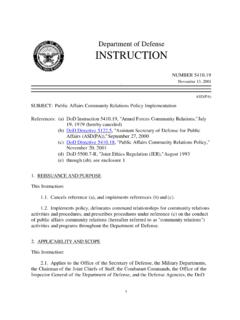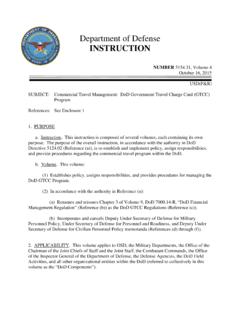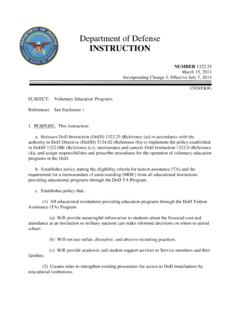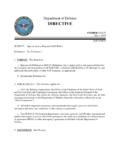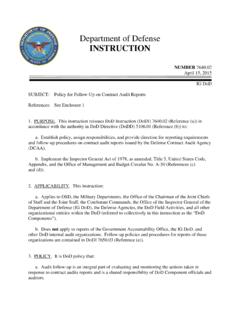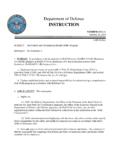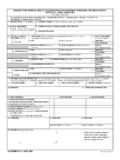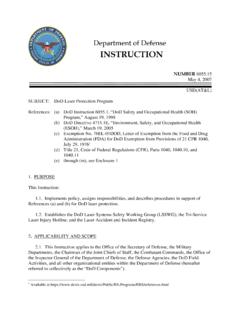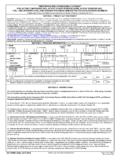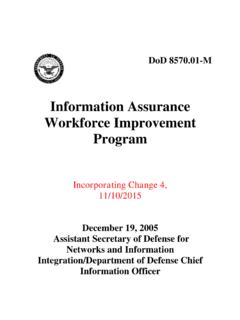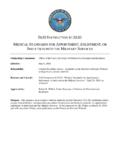Transcription of DoD Instruction 6490.07, February 5, 2010
1 department of defense Instruction . NUMBER February 5, 2010 . USD(P&R). SUBJECT: Deployment-Limiting Medical Conditions for Service Members and DoD Civilian Employees References: See Enclosure 1. 1. PURPOSE. In accordance with the authority in DoD Directive (DoDD) (Reference (a)) and the guidance in DoDDs and (References (b) and (c)), this Instruction establishes policy, assigns responsibilities, and provides procedures for ensuring that Service members and DoD civilian employees, including Coast Guard Service members and civilian employees at all times, including when the Coast Guard is a Service in the department of Homeland Security by agreement with that department , (hereafter referred to collectively as DoD personnel )
2 Deployed and deploying on contingency deployments are medically able to accomplish their duties in deployed environments. 2. APPLICABILITY. This Instruction : a. Applies to: (1) OSD, the Military Departments (including the Coast Guard at all times, including when it is a Service in the department of Homeland Security by agreement with that department ), the Office of the Chairman of the Joint Chiefs of Staff and the Joint Staff, the Combatant Commands, the Office of the Inspector General of the department of defense , the defense Agencies, the DoD Field Activities, and all other organizational entities within the department of defense (hereafter referred to collectively as the DoD Components ).
3 (2) DoD personnel deployed and deploying on contingency deployments consistent with DoD and Service-specific guidance, including Reference (c) and DoD Instruction (DoDI). (Reference (d)). b. Does not apply to contingency contractor personnel, who shall comply with the guidance in DoDI (Reference (e)), or to shipboard operations that are not anticipated to involve operations ashore, which shall follow Service-specific guidance. DoDI , February 5, 2010 . c. Shall be used as a minimum medical standard for all deploying and deployed DoD.
4 Personnel, BUT does not alter or replace: (1) With respect to military personnel, the accession, retention, and general fitness for duty standards previously established by the department of defense , including those described in DoDI , DoDD , Under Secretary of defense for Personnel and Readiness (USD(P&R)) Memorandum, Assistant Secretary of defense for Health Affairs (ASD(HA)). Memorandum, and DoDI (References (f) through (j), respectively). (2) With respect to civilian employees covered by sections 791 and 794a of title 29, United States Code (also known and hereafter referred to as The Rehabilitation Act of 1973, as amended (Reference (k))), the legal obligations of a DoD Component as an employer pursuant to that Act.
5 (3) More stringent individual Military department policy guidance or Service-specific readiness requirements. 3. DEFINITIONS. These terms and their definitions are for the purpose of this Instruction . a. contingency. A situation requiring military operations in response to natural disasters, terrorists, subversives, or as otherwise directed by appropriate authority to protect US interests. b. contingency deployment. A deployment that is limited to outside the continental United States, over 30 days in duration, and in a location with medical support from only non-fixed (temporary) military medical treatment facilities.
6 It is a deployment in which the relocation of forces and materiel is to an operational area in which a contingency is or may be occurring. c. deployment. The relocation of forces and materiel to desired operational areas. Deployment encompasses all activities from origin or home station through destination, specifically including intra-continental United States, inter-theater, and intra-theater movement legs, staging, and holding areas. d. medical assessment. The total of the pre-deployment activities described in section 1 of Enclosure 2 of this Instruction and those listed in paragraph of DoDI (Reference (l)).
7 E. trained DoD health-care provider. A physician, physician assistant, nurse practitioner, advanced practice nurse, independent duty corpsman, independent duty medical technician, or special forces medical sergeant. 4. POLICY. It is DoD policy that: a. The medical standards in this Instruction are mandatory for contingency deployments, and permissible for any other deployment, based on the commander's decision. 2. DoDI , February 5, 2010 . b. DoD personnel with existing medical conditions may deploy based upon a medical assessment as described in Enclosure 2 and subparagraph of Reference (l), which for civilian employees shall be consistent with subparagraph (3)(c) of DoDD (Reference (m)), and the requirements of The Rehabilitation Act of 1973, as amended, when such civilian employees are covered by that Act, if all of these conditions are met.
8 (1) The condition is not of such a nature or duration that an unexpected worsening or physical trauma is likely to have a grave medical outcome or negative impact on mission execution. (2) The condition is stable and reasonably anticipated by the pre-deployment medical evaluator not to worsen during the deployment in light of physical, physiological, psychological, and nutritional effects of the duties and location. (3) Any required, ongoing health care or medications anticipated to be needed for the duration of the deployment are available in theater within the Military Health System.
9 Medication must have no special handling, storage, or other requirements ( , refrigeration, cold chain, or electrical power requirements). Medication must be well tolerated within harsh environmental conditions ( heat or cold stress, sunlight) and should not cause significant side effects in the setting of moderate dehydration. (4) There is no need for routine evacuation out of theater for continuing diagnostics or other evaluations. (All such evaluations should be accomplished before deployment.). (5) In the case of civilian employees covered by The Rehabilitation Act of 1973, as amended, it is determined, based upon an individualized assessment, that the employee can perform the essential functions of the position in the deployed environment, with or without a reasonable accommodation, without causing undue hardship.
10 In evaluating undue hardship, the nature of the accommodation and the location of the deployment must be considered. Further, the employee's medical condition must not pose a significant risk of substantial harm to the employee or others taking into account the condition of the relevant deployed environment. c. Individuals with the conditions in Enclosure 3, based on medical assessments in accordance with Enclosure 2 and Reference (l), shall not deploy unless a waiver can be granted according to the procedures in section 3 of Enclosure 2.
